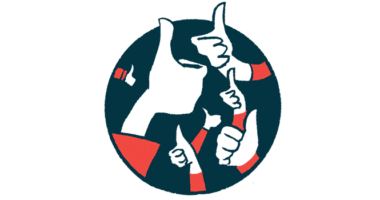Uplizna May Be Effective for Patients Without Anti-AQP4 Antibodies

Long-term treatment with Uplizna (inebilizumab-cdon) safely and effectively reduced the frequency of attacks in the 12 neuromyelitis optica spectrum disorder (NMOSD) patients who were negative for antibodies against aquaporin-4 (AQP4) in the N-MOmentum Phase 2/3 trial.
Future, appropriately-controlled studies are needed to confirm Uplizna’s benefits in this subgroup of NMOSD patients, the researchers noted.
These are the findings of a post hoc analysis of the trial’s data, which were published in the journal Multiple Sclerosis and Related Disorders in a study, titled “AQP4-IgG-seronegative patient outcomes in the N-MOmentum trial of inebilizumab in neuromyelitis optica spectrum disorder.”
NMOSD is an autoimmune disease in which the immune system wrongly produces antibodies that attack cells that support the nervous system, causing inflammation in the optic nerve and spinal cord. Most patients have high levels of antibodies against the AQP4 protein — a diagnostic hallmark of NMOSD — while some have antibodies against the myelin oligodendrocyte glycoprotein (MOG).
The absence of anti-AQP4 antibodies complicates NMOSD diagnosis, given its similarities with multiple sclerosis and other neuroinflammatory disorders. In addition, those positive for antibodies against MOG alone show a distinct disease profile from those with anti-AQP4 antibodies.
Currently, there are no approved therapies for NMOSD patients without anti-AQP4 antibodies (AQP4-negative) or with antibodies against MOG (MOG-positive).
Horizon Therapeutics’ Uplizna is a B-cell depleting therapy approved in the U.S. for adults with AQP4-positive NMOSD. Administered directly into the bloodstream twice a year, the therapy promotes the death of B-cells — the immune cells that make antibodies — by targeting a protein called CD19 found at their surface.
Uplizna’s approval was based on positive results from the company-sponsored N-MOmentum trial (NCT02200770), which tested the therapy in 230 NMOSD adult patients with or without anti-AQP4 antibodies.
Participants, of whom 92% were AQP4-positive, were randomly assigned to receive Uplizna (174 patients) or a placebo (56 patients) on days 1 and 15, and were monitored for about 6.5 months.
After completing this placebo-controlled part, 216 patients (more than 90% from each group) chose to enter the trial’s open-label period (OLP), in which all received the therapy every six months for up to three years after the last participant had entered the OLP.
Data from N-Momentum’s placebo-controlled part showed that the study met its main goal, with Uplizna significantly reducing — by 72.8% — the risk of NMOSD attacks after 6.5 months. In addition, results from the OLP demonstrated that these benefits were sustained, with 83% of patients who received the treatment for at least four years remaining attack-free.
The post hoc analyses (statistical tests conducted after the trial has finished) reviewed the safety and clinical efficacy of Uplizna on the 16 AQP4-negative NMOSD patients who participated in the trial. Uplizna was given to 12 of them, of whom six were MOG-positive. The placebo was given to the remaining four, of whom one was MOG-positive.
Results showed that, during the placebo-controlled period, three (25%) Uplizna-treated patients experienced a mild NMOSD attack, while none occurred among those in the placebo group. No further attacks were seen in the OLP, including among patients who were initially assigned to a placebo.
Given the small number of patients in the placebo group and the fact that none had an attack during the trial’s first part, “direct interpretation of between-group differences was not possible,” the researchers wrote.
As such, the team looked at differences in annualized attack rates (AARs) in the two years prior to Uplizna treatment (at the trial’s start or at OLP entry) and at the end of the study.
Data showed that among the 16 AQP4-negative participants, AARs dropped from a mean of 1.7 relapses per year to 0.048 after up to four years of treatment. Similar reductions were observed among the seven patients with anti-MOG antibodies (1.93 vs. 0.043) and the nine participants who tested negative for such antibodies (1.6 vs. 0.051).
These results were also comparable to those previously reported for AQP4-positive patients, who showed an AAR reduction from 1.35 to 0.097.
In addition, the effect of Uplizna “on the probability of remaining attack-free was similar between AQP4− [AQP4-negative] and AQP4+ [AQP4-positive] participants and remained stable with multiple dosing,” the researchers wrote.
The team then analyzed the therapy’s effects on other outcomes by comparing AQP4-negative patients who had been on Uplizna since the start of the study with a placebo group that consisted of those with and without anti-AQP4 antibodies.
Results showed that Uplizna treatment was associated with a lower chance of disability worsening and with fewer active brain lesions, but these differences did not reach statistical significance.
Moreover, the therapy was generally well-tolerated by AQP4-negative patients, showing a safety profile similar to that reported for AQP4-positive participants. Treatment also led to a similar degree of B-cell depletion between patients with anti-AQP4 antibodies and those without such antibodies.
“Data on participants with AQP4− NMOSD from randomized studies are rare and of clinical interest,” the team wrote, adding that this study “suggests that AQP4− participants may benefit from [Uplizna] treatment.”
“Further studies are needed to confirm these results,” the researchers wrote.
The team also noted that only 18 (36%) of the 50 AQP4-negative patients were considered eligible for participation, with the most common reason for exclusion being failure to fulfill diagnostic MRI criteria.
Two of these participants were later excluded from the analysis for different reasons: one had an NMOSD attack before the first Uplizna dose, while the other was later found to be AQP4-positive.
“This study highlights some of the core challenges in diagnosing AQP4− NMOSD and treating patients with this diagnosis and provides limited data on the effects of B-cell depletion with [Uplizna] in these participants,” the researchers wrote.
Of note, the researchers have financial ties to Horizon and/or other pharmaceutical companies.








